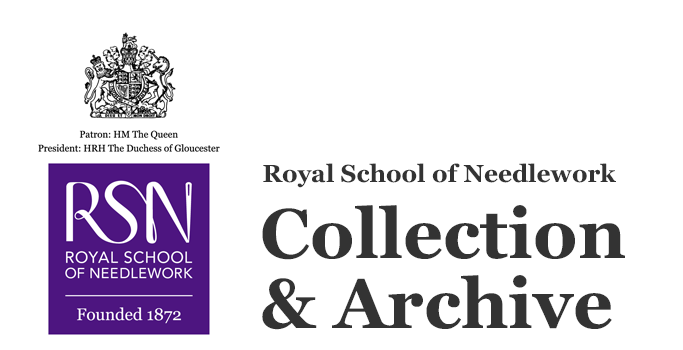Pattern
Object name
Published by
Date made
1852-1853
Place made
Description
Paper pattern for floral Berlin wool work embroidery, published by Magasin des Demoiselles in 1852-1853.
Content description
A 1852-1853 printed paper design for Berlin wool work, published in Paris. The design features three open and two budding roses, leaves, and vines. Below the pattern is a grid with the colours present in the floral design, perhaps a suggestion for a border that could be stitched alongside the design. The design is in colour and each stitch is indicated on a grid as is typical for Berlin wool work. The pattern is inscribed with, '10 Francs par an pour Paris', 'MAGASIN DES DEMOISELLES', and '12 francs pour les Départements' at the top and 'Paris, Imprimerie de Digeon r. Galande, 65', 'Bureaux du Journal', 'PARIS Rue Laffitte, No 51', and '1852-1853' at the bottom. The floral pattern is labelled 'No. 5' and the border labelled 'No. 6'.
Berlin wool work was a very popular style of embroidery in Europe throughout the 19th century, especially in the middle and later decades. It developed in Germany and rapidly spread across Europe and North America. Berlin wool work often involved brightly coloured threads, which were newly affordable thanks to the advent of aniline dyes. These colourful threads were made of wool, which were used to stitch on a canvas grid either in tent stitch or in cross stitch. Printed and hand-coloured patterns such as this one were inexpensive and distributed widely. This pattern was published in the Magasin des Demoiselles, a monthly ladies’ magazine published in Paris at 51 Rue Laffitte in the second half of the 19th century. Because Berlin wool work uses simple stitches and relied on inexpensive materials and patterns, it was accessible to embroiderers across a wide range of incomes and skill levels.
Berlin wool work was a very popular style of embroidery in Europe throughout the 19th century, especially in the middle and later decades. It developed in Germany and rapidly spread across Europe and North America. Berlin wool work often involved brightly coloured threads, which were newly affordable thanks to the advent of aniline dyes. These colourful threads were made of wool, which were used to stitch on a canvas grid either in tent stitch or in cross stitch. Printed and hand-coloured patterns such as this one were inexpensive and distributed widely. This pattern was published in the Magasin des Demoiselles, a monthly ladies’ magazine published in Paris at 51 Rue Laffitte in the second half of the 19th century. Because Berlin wool work uses simple stitches and relied on inexpensive materials and patterns, it was accessible to embroiderers across a wide range of incomes and skill levels.
Dimensions
width: 34.5cm
height: 16cm
height: 16cm
Materials
Techniques
Motifs
Catalogue number
ARCH.7
© Royal School of Needlework

